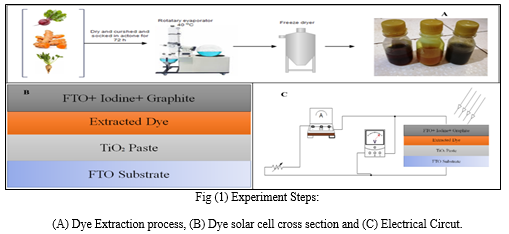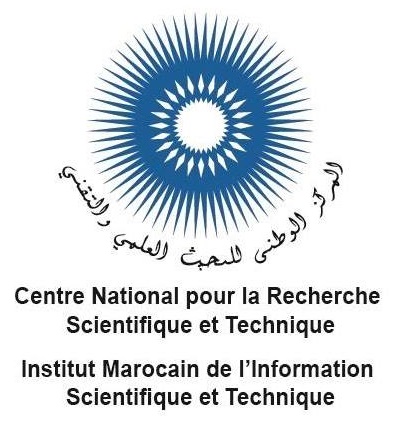Optical properties and efficiency studies for Beta Vulgarize, Curcuma Longa and Vulgaris var. cicla dye sensitized solar cell
Keywords:
DSSCs, UV-vis, FTIR, IV characteristic, Solar energyAbstract
The sun light, that gives the clean, fleckless and cheap energy which is an environmental friend; becomes the demand and on-call of the researchers in the last century. In this paper, the three natural dyes, namely; (Beta Vulgarize, Curcuma Longa and Vulgaris var. cicla) were successfully and swimmingly synthesized by dissolved in acetone solvent. The optical properties; absorbance, transmission, reflection, absorption coefficient and energy band gap were carefully and solicitously studied using ultra violet visible spectrometer UV.vis. The vibration modes for the three samples were also determined and delimited using Fourier Transform Infra-red spectroscopy FTIR. The efficiency of dye sensitized solar cell DSSC was studied using and utilisation IV characteristic for three natural dyes (Beta Vulgarize, Curcuma Longa and Vulgaris var. cicla), where the cell was fabricated and processed by coating a conducting proceeding substrate of (FTO) using titanium dioxide TiO2. The power conversion efficiency was calculated and reckoned, which found to be [0.583, 0.539 and 0.285], respectively. The highest efficiency obtained from this DSSC sensitized by Beta Vulgarize which was 0.583%, and thus might be due to its concentrated, focussed dye and colour.
Downloads
References
Arnaoutakis, Georgios E, Jose Marquse-hues, Aruna lvaturi, Stefan Fischer, Jan C Goldschmidt, Karl W Kramer, and Bryce S Richartds.Solar Energy Materials and Solar Cells. Vol. 140, pp. 217-23, 2015.
Askari Mohammad Bagher, Mirzaei Mahmoud Abadi Vahid, Mirhabibi Mohsen. Types of Solar Cells and Application. “American Journal of Optics and Photonics”. Vol. 3, No. 5, 2015.
Boschloo G, Improving the Performance of Dye-Sensitized Solar Cells. “Sweden Front. Chem”. 2019.
Jinghua Hu1, Jiejie Cheng, Shengqiang Tong, Li Zhao, Jinxia Duan, Yingping Yang, Dye-sensitized solar cells based on P25 nanoparticles/TiO2 nanotube arrays/hollow TiO2 boxes three-layer composite film. “Mater Sci: Mater Electron”. Vol. 27, pp. 5362-5370, 2016.
Nowacki L, Vigneron P, Rotellini L, Cazzola H, Merlier F, Prost E, et al. “Phytotherapy research: PTR”. Vol. 29, pp. 1964-73, 2015.
Nade VS, Kawale LA, Zambre SS, Kapure AB. “Indian journal of pharmacology”. Vol. 47[4], pp. 403-8, 2015.
] Kazimierczak R, Hallmann E, Lipowski J, Drela N, Kowalik A, Pussa T, et al. “Journal of the science of foodand agriculture”. Vol. 94 [13], pp. 2618-29, 2014.
Citores L, Iglesias R, Gay C, Ferreras JM. “Molecular plant pathology”. Vol. 17[2], pp. 261-71, 2016.
Oztay F, Sacan O, Kayalar O, Bolkent S, Ipci Y, Kabasakal L, et al. “Pharmaceutical biology”. Vol. 53[11], pp. 1639-46, 2015.
Martinez RM, Longhi-Balbinot DT, Zarpelon AC, Staurengo-Ferrari L, Baracat MM, Georgetti SR, et al.
“Archives of pharmacal research”. Vol. 38[4], pp. 494-504, 2015.
Kapadia GJ, Rao GS, Ramachandran C, Iida A, Suzuki N, Tokuda H. “Journal of complementary & integrative medicine”. Vol. 10, 2013.
Gupta, S.C, Sung, B, Kim, J.H Prasad, S, Li, S. Aggarwal, B.B. Multitargeting by Turmeric, the Golden Spice From Kitchen to Clinic. “Mol. Nutr. Food Res”. Vol. 57, pp. 1510-1528. 2013.
Prasad, S.; Aggarwal, B.B. Turmeric, the Golden Spice: From Traditional Medicine to Modern Medicine. In Herbal Medicine: Biomolecular and Clinical Aspects; Benzie, I.F.F., Wachtel-Galor, S., Eds.; CRC Press/Taylor & Francis: Boca Raton, FL, USA, 2011.
Miao; Li, C, Miao, X.; Li, F.; Adhikari, B.K.; Liu, Y.; Sun, J.; Zhang, R.; Cai, L.; Liu, Q.; Wang, Y. Curcuminoids: Implication forInflammation and Oxidative Stress in Cardiovascular Diseases. “Phytother. Res”. Vol. 33, pp. 1302-1317, 2019.
Brundin, P.; Melki, R.; Kopito, R. Prion-like Transmission of Protein Aggregates in Neurodegenerative Diseases. “Nat. Rev. Mol. Cell Biol”. Vol. 11, pp. 301-307, 2010.
Jana Streyczek and et al, Turmeric Extract (Curcuma longa) Mediates Anti-Oxidative Effects by Reduction of Nitric Oxide, iNOS Protein-, and mRNA-Synthesis in BV2 Microglial Cells (2022). “Molecules”. Vol. 27, pp. 784, 2022.
Hussam Zein and et al, The antioxidant and Anticancer Activities of Swiss Chard and Red Beetroot Leaves, “Current Science International”. Vol. 4 Issue: 4, pp. 491-498, 2015.
Rajakannu S, Sritharan UR and Rajiv GS. Phytochemical Screening, Antimicrobial Activity and In Vitro Antioxidant Investigation of Methanolic Extract of Seeds from Helianthus annuus
L. “Chemical Science Review and Letters”. Vol. 1(1), pp. 30-34, 2012.
Faten Zahran Mohamed and et al. Biochemical and phytochemical studies on Balanities aegyptiaca fruits. “Scientific Research & Studies Center-Faculty of Science- Zagazig University- Egypt Biochemistry Letters”. Vol. 10(2), pp. 13-26, 2015.

Downloads
Published
How to Cite
Issue
Section
License
Copyright (c) 2022 yousif alsabah

This work is licensed under a Creative Commons Attribution 4.0 International License.
Copyright on any article in the International Journal of Engineering and Applied Physics is retained by the author(s) under the Creative Commons license, which permits unrestricted use, distribution, and reproduction provided the original work is properly cited.
License agreement
Authors grant IJEAP a license to publish the article and identify IJEAP as the original publisher.
Authors also grant any third party the right to use, distribute and reproduce the article in any medium, provided the original work is properly cited.
Most read articles by the same author(s)
- Khaled Laqal, Siddig Tawaer Kafi, yousif alsabah, Abobakr A. M. Salem, Study of Environmental Pollution Rustling from Balhaf Liquid Natural Gas Station Using Spectroscopy Analysis, Shabwah Governorate – Yemen , International Journal of Engineering and Applied Physics: Vol. 2 No. 2: May 2022
- yousif alsabah, Suliman A. Abadalla, Abdelrahman A. Elbadawi, Hassan H. Abuelhassan, Assessment of wind energy potential in Nyala: South Darfur state, Sudan , International Journal of Engineering and Applied Physics: Vol. 4 No. 3: September 2024
- Reham Seddig Mohammed Ahmed, yousif alsabah, Ali A. S. Marouf , Electrochemical Performance of Laser Modified Zinc Electrode , International Journal of Engineering and Applied Physics: Vol. 2 No. 3: September 2022














